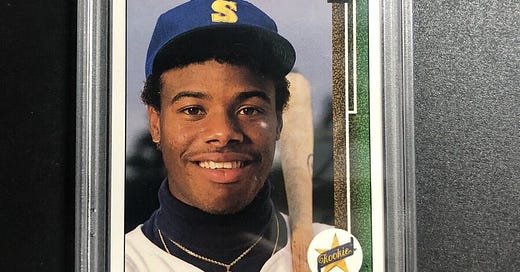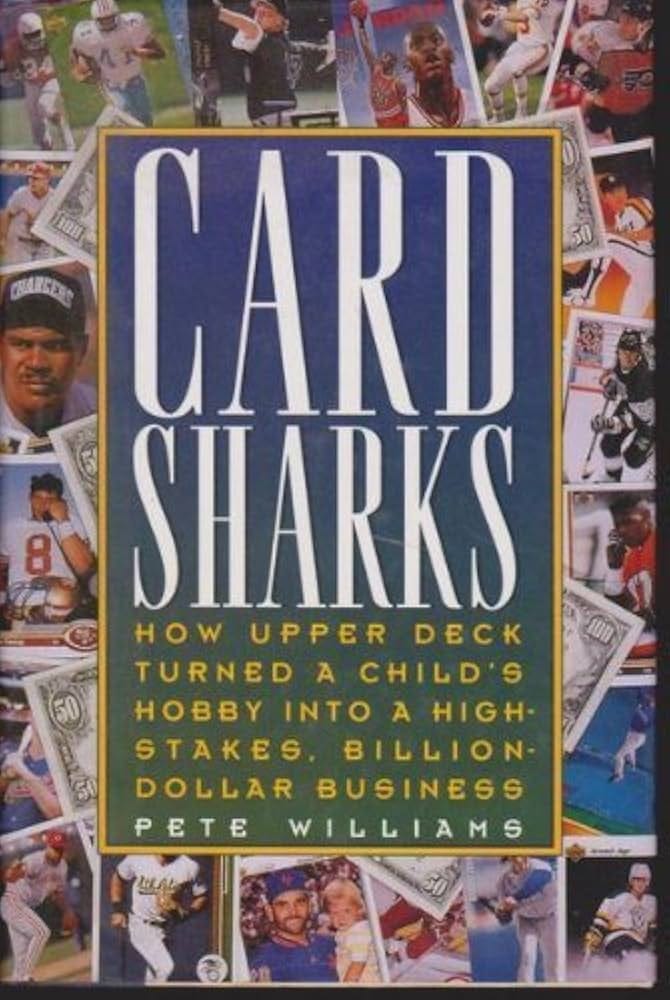Did Upper Deck Reprint Its Key Cards?
If somebody mentions 1989 Upper Deck, most of us think immediately about this card:
Just as the 1986 Donruss Jose Canseco was the card of the 1980s, this Griffey rookie has become the most iconic card of the entire “junk wax” era. It represented Upper Deck’s sudden burst on the scene in the late 1980s, and really is a symbol for what the future of baseball cards held: high quality paper, excellent photography, and counterfeit proof technology.
But there’s a really good chance that the company cheated.
Now, I should note that “cheating” here doesn’t mean anything illegal. Card companies can print as many cards as they want in whatever manner they want. Even to this day, there’s really not much protection against “insider trading” in the trading card industry.
Most of the rumors I’ve heard come from this 1995 book on the history of Upper Deck:
Card Sharks was controversial when it was released, and remains controversial to this day. However, the rumors about 1989 Upper Deck baseball include:
Certain valuable cards were reprinted after the print run technically ended and given to high ranking company staff to sell out the back door
Certain error cards were deliberately reprinted for resale, again through the back door
The original 1989 Upper Deck set may have remained in print for years after it was thought to have ended
Now, we do need to take all of this with a grain of salt. One thing we tend to forget today is just how big the baseball card industry was between 1989 and 1992.
As quoted in this Net54 thread, Williams estimated that 125,000 cases of 1989 Upper Deck were created — not counting cards sold outside normal packs (i.e. as complete sets). That gives us 1.4 billion cards, or around 2 million of each card in the 700 card first series set.
Most estimates around that Griffey rookie are that over 1 million copies were printed. And, honestly, when our estimates are somewhere in the 1 million to 2 million range, it doesn’t really matter if the company printed a few special boxes of 1,000 copies of a single card to sell out the back door.
To give you an idea, check out the PSA population numbers for that Griffey rookie:
If we use the conservative estimate of a print run of 1 million, then about 16% of all 1989 Griffey cards have been graded by PSA. And the amazing part is that even though there are over 4,000 PSA 10 cards, the average price remains high. Remember that this also does not count the other grading companies.
While looking at sold listings on eBay, I came across this recent sale:
This tells me that demand for the card remains strong despite the fact that the population is so high.
This is also why it’s possible to see crazy auctions like this pop up from time to time:
And, if you’ve ever doubted that the junk wax era was a real thing, consider this crazy auction:
Now, is it possible that Upper Deck engaged in some shenanigans to make extra money off the unexpected demand for its initial baseball set? Absolutely. I’d be surprised if they didn’t.
But does it really matter in the long run? Probably not.
The truth is that the possible presence of a few thousand extra Griffey rookie cards really hasn’t done anything to hurt the price. It remains one of the few junk wax era cards to have appreciated in value, and exemplars in the highest conditions show no signs of slowing down. Despite the effects of the 1994 strike, the collapse of the larger segment of the baseball card collecting industry, and the eventual realization that there are far too many 1988-1992 cards out there, 1989 Upper Deck has somehow managed to keep a foothold in the hobby.
Demand doesn’t lie. And the truth is that the demand for this set, and this card in particular, remains high to this day. Even though we know there are tons of these cards out there.









